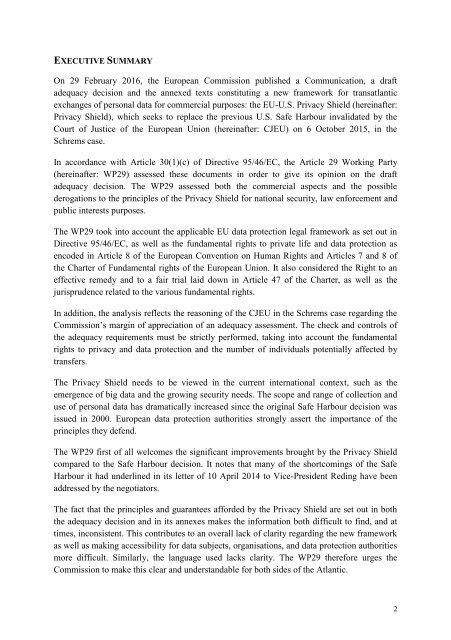ARTICLE 29 DATA PROTECTION WORKING PARTY
1SANK0H
1SANK0H
Create successful ePaper yourself
Turn your PDF publications into a flip-book with our unique Google optimized e-Paper software.
EXECUTIVE SUMMARY<br />
On <strong>29</strong> February 2016, the European Commission published a Communication, a draft<br />
adequacy decision and the annexed texts constituting a new framework for transatlantic<br />
exchanges of personal data for commercial purposes: the EU-U.S. Privacy Shield (hereinafter:<br />
Privacy Shield), which seeks to replace the previous U.S. Safe Harbour invalidated by the<br />
Court of Justice of the European Union (hereinafter: CJEU) on 6 October 2015, in the<br />
Schrems case.<br />
In accordance with Article 30(1)(c) of Directive 95/46/EC, the Article <strong>29</strong> Working Party<br />
(hereinafter: WP<strong>29</strong>) assessed these documents in order to give its opinion on the draft<br />
adequacy decision. The WP<strong>29</strong> assessed both the commercial aspects and the possible<br />
derogations to the principles of the Privacy Shield for national security, law enforcement and<br />
public interests purposes.<br />
The WP<strong>29</strong> took into account the applicable EU data protection legal framework as set out in<br />
Directive 95/46/EC, as well as the fundamental rights to private life and data protection as<br />
encoded in Article 8 of the European Convention on Human Rights and Articles 7 and 8 of<br />
the Charter of Fundamental rights of the European Union. It also considered the Right to an<br />
effective remedy and to a fair trial laid down in Article 47 of the Charter, as well as the<br />
jurisprudence related to the various fundamental rights.<br />
In addition, the analysis reflects the reasoning of the CJEU in the Schrems case regarding the<br />
Commission’s margin of appreciation of an adequacy assessment. The check and controls of<br />
the adequacy requirements must be strictly performed, taking into account the fundamental<br />
rights to privacy and data protection and the number of individuals potentially affected by<br />
transfers.<br />
The Privacy Shield needs to be viewed in the current international context, such as the<br />
emergence of big data and the growing security needs. The scope and range of collection and<br />
use of personal data has dramatically increased since the original Safe Harbour decision was<br />
issued in 2000. European data protection authorities strongly assert the importance of the<br />
principles they defend.<br />
The WP<strong>29</strong> first of all welcomes the significant improvements brought by the Privacy Shield<br />
compared to the Safe Harbour decision. It notes that many of the shortcomings of the Safe<br />
Harbour it had underlined in its letter of 10 April 2014 to Vice-President Reding have been<br />
addressed by the negotiators.<br />
The fact that the principles and guarantees afforded by the Privacy Shield are set out in both<br />
the adequacy decision and in its annexes makes the information both difficult to find, and at<br />
times, inconsistent. This contributes to an overall lack of clarity regarding the new framework<br />
as well as making accessibility for data subjects, organisations, and data protection authorities<br />
more difficult. Similarly, the language used lacks clarity. The WP<strong>29</strong> therefore urges the<br />
Commission to make this clear and understandable for both sides of the Atlantic.<br />
2


